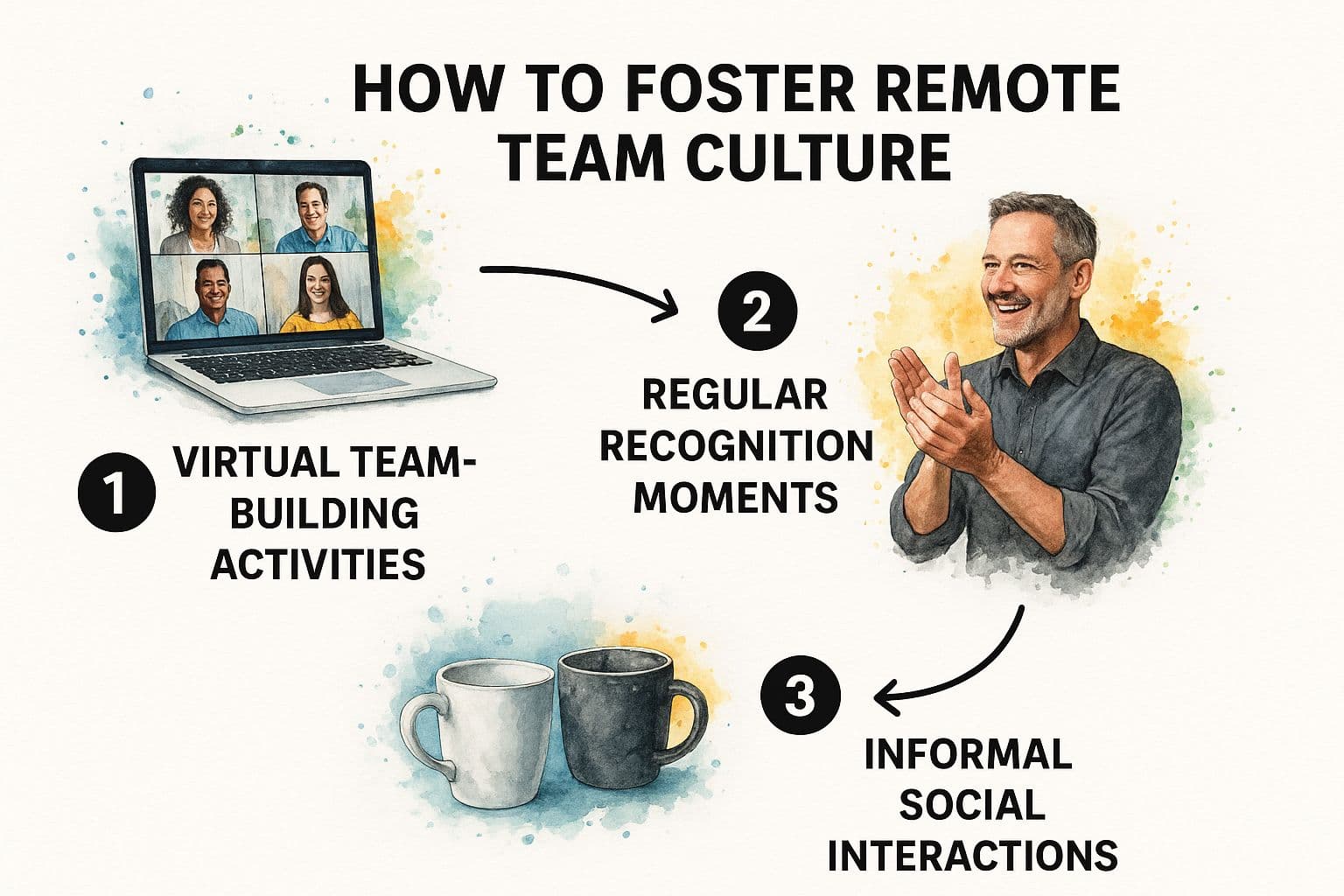Learn how to manage a remote team with proven strategies for communication, culture, and accountability. A practical guide for today's leaders.
July 18, 2025 (5mo ago) — last updated December 19, 2025 (Today)
How to Manage a Remote Team for Success
Learn how to manage a remote team with proven strategies for communication, culture, and accountability. A practical guide for today's leaders.
← Back to blog
When you boil it down, leading a remote team successfully rests on three core pillars: deliberate communication, autonomy built on trust, and having the right tech stack. The goal isn't to just slap a digital version of your physical office online. It's about building entirely new, intentional systems that give your distributed team the freedom and structure to do their best work.
The Modern Playbook for Remote Leadership
The move to distributed work isn't a temporary trend; it's a permanent shift in how we operate. This changes not just where we work, but fundamentally how we lead. The old "management by walking around" style is officially obsolete. Today’s best leaders are proactive, swapping physical presence for clearly defined systems that drive clarity, connection, and accountability.
This new playbook means leaving office-centric habits behind. Instead of relying on spontaneous water-cooler chats, you have to master asynchronous communication. Instead of watching the clock, you have to focus on outcomes. This is the bedrock of a high-performing team that can succeed from anywhere.
Adopting a Remote-First Mindset
A remote-first mindset means you design every workflow, cultural ritual, and communication channel as if no one has a central office. This simple but powerful shift ensures everyone is on a level playing field, no matter where they are. It also forces a level of clarity and purpose that, frankly, benefits the entire business.
So, what does this look like in practice?
- Default to Documentation:** Every process, decision, and project update needs a home—a single source of truth that anyone can access at any time.
- Trust Over Surveillance: Give your team the autonomy to own their schedules and manage their tasks. The focus has to be on the quality of the results, not the hours logged.
- Communicate Asynchronously First: Prioritize clear, detailed written communication. This respects different time zones and gives people the space to provide thoughtful, well-considered responses.
"The biggest shift for managers is moving from being a director of work to a facilitator of outcomes. Your job is to remove roadblocks, provide resources, and build the scaffolding of trust and communication that allows your team to succeed independently."
This cultural pivot is non-negotiable now. The global workforce has fully embraced remote work, and the numbers back it up. Projections show that by 2025, a staggering 36.2 million Americans will be working remotely. That’s an 87% jump from pre-pandemic levels. For a deeper dive into the principles behind a thriving distributed team, check out these strategies for leading remote success. This is why organizations are being forced to completely rethink how they manage people to keep them productive and happy long-term.
To put these principles into a clearer framework, let's summarize the core pillars of effective remote management.
Core Pillars of Remote Team Management
This table breaks down the essential actions and their importance, serving as a quick reference for building a successful remote team structure.
| Pillar | Key Action | Why It Matters |
|---|---|---|
| Deliberate Communication | Prioritize asynchronous channels and establish clear guidelines for when to use synchronous tools (like video calls). | It creates an inclusive environment for all time zones, reduces meeting fatigue, and encourages thoughtful, well-documented conversations. |
| Trust-Based Autonomy | Focus on outcomes, not activity. Give your team ownership of their projects and schedules. | It empowers employees, boosts morale, and fosters a culture of accountability and innovation. Micromanagement kills productivity. |
| The Right Technology | Equip your team with a central platform for collaboration, project management, and communication. | The right tools reduce friction, eliminate information silos, and provide a single source of truth, making work seamless. |
Ultimately, these pillars work together to create a resilient, engaged, and high-performing remote team.
In the next sections, we'll get into the weeds. I’ll give you the practical, step-by-step guidance you need to turn these principles into reality. You'll learn exactly how to build the systems that drive performance, culture, and engagement for your own distributed team.
Mastering Asynchronous Communication

In a typical office, you can get away with a certain amount of communication chaos. A quick question over the cubicle wall or a spontaneous hallway chat can clear up confusion in seconds. But when you’re managing a remote team, that safety net is gone. Success hinges on being far more intentional with a communication strategy that’s clear, deliberate, and mostly asynchronous.
This isn’t just about cutting down on meetings. It's a fundamental shift in how your team operates. The goal is to move away from an "always-on" culture of instant replies and constant notifications and toward a system that respects different time zones and protects everyone’s ability to do deep, focused work. To get there, you need robust remote team communication strategies that truly bridge the distance.
Establish a Single Source of Truth
Information silos are the silent killers of remote productivity. When project briefs, crucial feedback, or final decisions are scattered across emails, chat threads, and random documents, your team wastes precious time just trying to find what they need. Or worse, they redo work because they couldn't find the right version.
The very first step is to declare war on this chaos by creating a single source of truth (SSOT).
Think of it as the central hub for everything important. It could be a dedicated project space in Fluidwave, a detailed knowledge base, or even just a meticulously organized folder system. The tool itself matters less than the team-wide commitment to using it religiously. Every major update, key document, and final decision must live here. This one habit empowers your team to work with confidence and autonomy.
Set Crystal Clear Communication Channel Rules
Not all messages are created equal, so why treat all your communication tools the same? A classic mistake I see managers make is letting every type of conversation—urgent, non-urgent, social, and project-specific—collide in one place like a single chat app. The result is a firehose of notifications that creates constant distraction.
You can bring order to this madness by defining clear "rules of the road" for each tool. This helps everyone manage their attention and sets clear expectations for response times.
A Practical Example for Channel Guidelines:
| Tool | Purpose | Expected Response Time |
|---|---|---|
| Fluidwave Tasks | Project updates, assignments, formal feedback, and task-specific questions. This is where documented work happens. | Within 24 hours. |
| Instant Messaging | Quick, non-urgent questions or social chatter. True emergencies should be explicitly marked. | Within 3-4 business hours. Not for constant monitoring. |
| Formal external communication or official company-wide announcements. | Within 48 hours. For less time-sensitive correspondence. | |
| Video Calls | Reserved for complex problem-solving, 1-on-1s, or critical team-building sessions. | Scheduled at least 24 hours in advance with a clear agenda. |
This structure is liberating. Team members know a notification from Fluidwave warrants a different kind of attention than a GIF in a social chat channel, allowing them to focus on what matters.
Train Your Team to Write for Clarity
When you work asynchronously, your writing does the heavy lifting. Vague, incomplete, or rambling updates just create more work by forcing a round of follow-up questions that a little forethought could have avoided. If you want to master remote management, you have to coach your team to write with absolute clarity.
An effective asynchronous update provides all necessary context upfront. It should clearly state the status, any blockers, and the next steps required, enabling a teammate to understand the full picture without needing a live conversation.
I encourage my teams to follow a simple framework for every significant update:
- Context: What is this about? Link to the relevant project or task.
- Status: What progress have you made? Be specific.
- Blockers: Are you stuck? What do you need from others to get moving again?
- Next Steps: What is the very next action, and who owns it?
This simple habit transforms communication from a source of friction into a tool for progress. It also makes it much easier to hold people accountable and to trace back decisions weeks or months later. When teams are juggling these tasks, learning https://fluidwave.com/blog/how-to-prioritize-tasks-at-work can be a total game-changer, ensuring that clear communication leads to efficient execution across any distance.
Intentionally Building a Strong Remote Culture
In an office, culture often feels like it just happens. It sprouts from shared lunches, random hallway chats, and those impromptu huddles around a whiteboard. When you go remote, all of that organic growth disappears. You can't just hope for a strong culture to emerge; you have to build it with the same focus you'd give your product roadmap.
Without that deliberate effort, your team doesn’t just feel disconnected. They start acting like a collection of freelancers who happen to get paid by the same company. The real work is moving beyond awkward virtual happy hours and creating meaningful rituals that build genuine connections. This isn't just a nice-to-have, it's a cornerstone of managing a successful remote team for the long haul.
Create Virtual Water Coolers
One of the biggest things we lose when we're not in the same building is the casual, non-work banter that builds real friendships. We have to be intentional about recreating those spaces online. This isn't just about morale; it's fundamental for building psychological safety and trust.
A simple but surprisingly effective way to do this is to create dedicated channels in your chat tool for everything but work.
- #pets-of-fluidwave: A non-stop stream of cute photos of our furry (or scaly) coworkers.
- #what-we-are-reading: For sharing book recommendations and sparking conversations.
- #weekend-wins: A spot to post a picture from a weekend hike or share a new recipe you nailed.
These channels give everyone permission to just be human and connect on a personal level. That foundation makes asking for help on a tough project or collaborating with someone you don't work with daily feel completely natural.
Implement Meaningful Recognition Programs
When everyone is behind a screen, great work can easily go unnoticed. That's a fast track to feeling undervalued and invisible. A formal, very visible recognition program is your best defense against this. It's not just about managers handing out praise, either; peer-to-peer recognition is often far more powerful.
When employees feel their contributions are consistently recognized, they are 2.7 times more likely to be highly engaged. This isn't just fluff—it reinforces the behaviors you want to see and makes people feel genuinely valued, which directly impacts morale and retention.
Fluidwave's shared task spaces are perfect for this. We created a "Team Wins" project board where anyone can add a card to give a public shout-out to a colleague. It creates a visible, lasting record of appreciation. Then, we take five minutes in our weekly team meeting to read a few of them out loud. It’s a small ritual that has a massive impact.
Redesign Your Onboarding for Connection
An employee's first few weeks will define their entire experience with your company. A bad remote onboarding—where you just ship a laptop and email a list of links—is a recipe for disengagement and quick turnover. Your process needs to be high-touch and human-centric from the very beginning.
The goal is to make every new hire feel like they're truly part of the team from day one.
- Assign an Onboarding Buddy: Pair them with a seasoned team member who isn't their direct manager. This person is their go-to for all the "silly" questions about company culture, how to use chat, and who's who.
- Schedule Introduction Calls: Don't rely on one big, awkward welcome meeting. Schedule a series of short, 15-minute one-on-one video calls with the key people they'll be working with across different departments.
- Create a Clear 30-60-90 Day Plan: This plan should be about more than just tasks. Include goals for learning and relationship-building. What key concepts should they grasp by day 30? Who should they have connected with by day 60?
This structured approach turns onboarding from a logistical checklist into a process of cultural integration. A great way to support this is by helping them set and track both professional and personal goals within their first few months, showing that you're invested in their whole person. Ultimately, building a vibrant remote culture is about establishing rituals that bring your values to life and make every single person feel essential.
Driving Performance Without Micromanaging

Let's be honest: one of the toughest adjustments for managers new to remote work is learning to trust the team they can't see. The urge to check online statuses or obsess over response times is strong, but it's a trap. The most successful remote leaders I know have made a crucial shift—they focus entirely on outcomes, not activity.
This isn't just about giving people autonomy. It’s about cultivating a high-trust environment where real ownership and accountability can flourish. When you define what success looks like and then step back, you empower your team to find the best, most creative ways to get there. Micromanagement, on the other hand, broadcasts a lack of trust that kills morale and innovation stone-dead.
Define Success with Crystal-Clear Goals
You can't manage by results if your team doesn't know what they're aiming for. Vague goals are the enemy; they lead to wasted effort, misaligned priorities, and frustration for everyone involved. A solid goal-setting framework is your best friend here.
Frameworks like Objectives and Key Results (OKRs) are practically built for remote teams because they create a clear, public hierarchy of goals. Everyone can see exactly how their individual work plugs into the bigger company mission.
- Objective: The big, inspiring goal. Think "Launch a World-Class Customer Onboarding Experience."
- Key Results: The measurable signs you've achieved it. For example, "Improve user activation rate by 15%" or "Achieve a customer satisfaction score of 95% for new users."
Inside a platform like Fluidwave, you can spin up a dedicated project for your team’s OKRs. This makes the goals impossible to ignore and lets you link specific tasks directly to the key results they support. Suddenly, there's a transparent line connecting daily work to strategic impact.
Make Work Visible and Transparent
With clear goals in place, the next move is to make the work itself transparent. This isn't about surveillance—it’s about providing clarity and making collaboration seamless. When everyone can see the status of a project, the need for constant "check-in" meetings evaporates.
This is where project management tools like Asana, Trello, or Fluidwave's own Kanban boards are indispensable. They create a shared visual space where tasks flow from "To Do" to "In Progress" to "Done." This system gives you a bird's-eye view, letting you spot bottlenecks or see who's overloaded without ever having to ask, "So, what are you working on?"
A transparent workflow also fosters a culture of mutual accountability. Team members can see how their part of the puzzle affects everyone else, which encourages proactive communication and much smoother handoffs.
Conduct Impactful One-on-One Meetings
Your one-on-one meetings are perhaps the most powerful tool for driving performance without ever slipping into micromanagement. These aren't status updates; that's what your project board is for. These conversations should be forward-looking discussions about development, roadblocks, and growth.
A great one-on-one agenda puts them in the driver's seat:
- Start with their agenda. Always ask what's on their mind first to give them ownership of the conversation.
- Check progress on goals. Talk about how they're tracking toward their OKRs or other defined goals.
- Uncover roadblocks. Ask questions like, "What's getting in your way? How can I help?" This positions you as a supportive resource, not an inspector.
- Discuss career development. Talk about their long-term aspirations and what they want to learn next.
These conversations build deep trust and show you're invested in their success as people, not just their output. For a deeper dive into structuring these evaluations, our guide offers some excellent frameworks.
A focus on outcomes pays dividends in remote settings. Well-documented research shows remote employees can see a 35% to 40% jump in productivity. In fact, 62% of workers feel more productive from home, thanks to fewer distractions and greater focus.
Ultimately, making remote performance boil down to a simple formula: Clarity + Trust + Accountability. Set clear goals, make the work visible, and focus your conversations on growth and removing obstacles. Do that, and you'll create an environment where your team delivers exceptional results—no shoulder-surfing required.
Building Your Remote Team Tech Stack
The right technology is the backbone of any successful remote team. It's the digital foundation that makes seamless communication, collaboration, and clarity possible, no matter where your people are located. But let's be clear: building a great tech stack isn't about grabbing every popular app off the shelf. That's a recipe for confusion and friction.
The real goal is to create an integrated ecosystem where the tools feel invisible. Technology should support the work, not become a chore in itself. This starts with a thoughtful look at your team's needs long before you even consider a free trial.
Auditing Your Core Collaboration Needs
Before you can pick the right tools, you have to deeply understand how your team actually works. A powerful tech stack is built on a foundation of self-awareness. So, start by asking some honest questions. How does information really flow from person to person? Where are the current communication bottlenecks slowing you down? What kind of collaboration does your team actually do day-to-day?
This audit will help you map out your must-haves across three critical areas:
- Communication: How will your team connect? This covers everything from quick, real-time chats and video calls for complex problem-solving to asynchronous updates that respect different time zones.
- Project Management: How will work get assigned, tracked, and completed? This is about creating a single source of truth so everyone knows who is doing what and by when. No more "I thought you were handling that."
- Document Collaboration: Where will your team create, share, and store collective knowledge? This is your digital filing cabinet for everything from project briefs and creative assets to company policies.
Your answers create a blueprint. For instance, a team scattered across the globe will lean heavily on asynchronous tools, while a team in the same time zone might prioritize real-time video. As you think through these needs, you can find great ideas by looking at curated lists of the top remote work apps for productivity.
The best remote tech stack feels like a cohesive ecosystem, not a random collection of apps. Each tool should have a distinct purpose, and they should integrate smoothly to prevent information silos and duplicate work.
The image below gives a great visual of how a well-managed remote environment functions. Your tech stack should be the engine that powers every one of these stages.

It’s a good reminder that your tools need to support the human connections that are the lifeblood of a strong, connected culture.
Choosing Your Remote Collaboration Tech Stack
With a clear picture of your needs, you can start looking at specific platforms. Always remember, the best tool is the one your team will actually use consistently. Prioritize simplicity, strong integration capabilities, and how well a tool fits into the workflows you’ve already established. Don’t force a square peg into a round hole.
Building an effective tech stack involves selecting tools that work together seamlessly. This table breaks down the core categories to help you make informed decisions.
| Tool Category | Primary Function | Popular Examples | Key Consideration |
|---|---|---|---|
| Project Management | Serves as the single source of truth for all work, tracking tasks from assignment to completion. | Fluidwave, Asana, Trello | Does it offer flexible views (Kanban, list, calendar) to match different work styles on your team? |
| Team Communication | Enables both real-time chats and asynchronous conversations for updates and announcements. | Slack, Microsoft Teams | Can you set up dedicated channels to keep project discussions separate from social watercooler talk? |
| Document Collaboration | Acts as a central hub for creating, co-editing, and storing team documents and knowledge. | Google Workspace, Notion | How robust are the version control and real-time co-editing features? Can you easily track changes? |
| Video Conferencing | Provides essential face-to-face interaction for meetings, 1-on-1s, and brainstorming sessions. | Zoom, Google Meet | Check for reliability, high-quality screen sharing, and simple recording and transcription features. |
Ultimately, a well-chosen tech stack reduces friction and empowers your team to do their best work without being bogged down by cumbersome software.
Hardware and Security Are Non-Negotiable
A fantastic software stack means very little if your team is struggling with slow computers or spotty, unsecured internet connections. Part of your responsibility as a remote leader is to ensure everyone has the physical equipment and security protocols they need to be productive and safe.
This means providing a budget for essentials like ergonomic chairs, high-quality webcams, and noise-canceling headsets. It’s an investment that pays off in both well-being and productivity.
On the security side, there's no room for compromise. You need to enforce smart security habits from day one. This includes mandating the use of a company VPN, requiring 2FA on all work-related accounts, and providing regular training on how to identify phishing scams. Security is a team sport.
The demand for remote work isn't going away. Recent data shows that while 30% of employees are fully remote, another 50% are in hybrid setups. These roles consistently attract 60% of all job applications, proving that flexibility is a massive draw for top talent. More importantly, studies show remote workers contribute an extra 51 productive minutes per day.
These figures tell a powerful story: investing in a robust tech stack isn't just an IT expense. It's a strategic move that helps you attract the best people and empowers them to perform at their peak.
Answering Your Top Remote Management Questions

Even with the best game plan, managing a remote team throws curveballs. I’ve seen it time and again. Instead of scrambling when a tricky situation pops up, it helps to have a playbook ready. Here, we’re tackling the questions I hear most from managers, with answers you can put into action right away.
This isn’t about high-level theory. It's about practical advice for the real problems you face. Think of this as your go-to guide for navigating the nuances of remote leadership.
How Do I Onboard a New Employee Remotely?
Onboarding a remote hire requires more intention and structure than its in-person counterpart. You can't just point them to their desk. The mission is to make them feel connected, equipped, and productive from day one, not left on an island to figure things out alone.
Your focus should be twofold: technical readiness and human connection. Start with a detailed digital onboarding packet. This should be more than just HR forms; include links to your knowledge base, key contacts, and a clear 30-60-90 day plan. This plan needs to outline not just performance expectations but also relationship-building goals, like who they should connect with in their first month.
Here's the real game-changer: set up a buddy system. Pair the new hire with a seasoned team member—someone they can go to with "silly" questions about company culture or how to navigate a specific tool. Schedule frequent, but brief, video check-ins during their first two weeks to build rapport and spot any potential issues before they grow.
What Is the Best Way to Handle Performance Issues?
Addressing performance issues from a distance demands a careful mix of hard data and genuine empathy. The absolute key is to be proactive and private, and to never jump to conclusions about why someone might be struggling.
First, gather objective facts. Are deadlines being missed? Are KPIs not being met? Look for specific project outcomes. A vague feeling that someone isn't pulling their weight isn't enough. Schedule a one-on-one video call and frame the conversation around support, not accusation.
Use concrete examples. Instead of "Your work has been slipping," try "I noticed the last three project milestones were submitted a day late. Is there anything blocking your progress?" This opens a dialogue. From there, you can work together on a documented Performance Improvement Plan (PIP) with measurable goals and a clear schedule for check-ins. This maintains trust while setting firm expectations.
When addressing performance, lead with curiosity. Asking "What resources do you need to succeed here?" positions you as a supportive coach rather than a disciplinarian, making the employee a partner in finding the solution. This fosters accountability without destroying morale.
How Can I Prevent Burnout and Isolation?
Burnout and isolation are the silent killers of productivity and morale in a remote environment. You can’t just hope your team finds a healthy work-life balance; you have to actively build a culture that supports it.
It starts with you. Lead by example. Take your vacation time, sign off at a reasonable hour, and talk openly about the importance of disconnecting. This gives your team the social permission to do the same. Another powerful tactic is to implement "no-meeting" days to give everyone deep, uninterrupted focus time.
Use your one-on-one meetings to check in on people as people. Go beyond project status and ask directly: "How is your workload feeling right now?" and "Are you feeling connected to the team?" Finally, create low-pressure ways to socialize, like a dedicated chat channel for hobbies or an optional 15-minute virtual coffee break.
How Do You Manage a Team Across Different Time Zones?
Leading a team spread across the globe is a masterclass in asynchronous work. If you try to force everyone into a single time zone's 9-to-5, you're setting yourself up for failure. The entire mindset has to shift.
Make asynchronous communication your default. All major decisions, project updates, and important discussions must be meticulously documented in a central hub, like your project management tool. This is non-negotiable; it ensures no one is left in the dark simply because of where they live.
When you absolutely must meet live:
- Rotate meeting times. Don't make the same people take the early morning or late-night hit every time.
- Define a core collaboration window. This is a 2-4 hour block where schedules overlap for truly urgent conversations.
- Record every single meeting. Share the recording and a summary immediately so those who couldn't be there can catch up on their own time.
This approach forces a culture of extreme clarity and detailed handoffs, allowing work to move forward seamlessly, 24/7.
Ready to implement these strategies with a tool built for clarity and focus? With Fluidwave, you can manage tasks, streamline communication, and delegate work to skilled assistants, all in one platform. Start simplifying your remote management today.
REQUIREMENTS:
- Remove each broken blog link completely (both the markdown link syntax and the descriptive text)
- Rewrite sentences naturally after removing references
- Preserve all other markdown formatting
- Only remove references to the specific broken blog links, don't change other content
- Process all broken URLs in a single pass
Example: for your small business.
Please return your response in the following JSON format: { "updatedContent": "the full content with all broken links removed", "removals": [ { "brokenUrl": "https://fluidwave.com/blog/small-business-tips", "explanation": "Removed the broken link reference and updated surrounding sentence to read naturally." } ] }
Focus on What Matters.
Experience lightning-fast task management with AI-powered workflows. Our automation helps busy professionals save 4+ hours weekly.